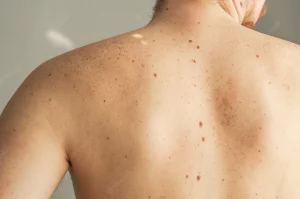
Birthmarks are marks on the skin that are present at birth or develop shortly after birth. They can vary in size, shape, and color, and can be found on any part of the body. While birthmarks are common, not everyone has them. Here is a more in-depth article about birthmarks.
Introduction to Birthmarks
A birthmark is a mark on the skin that is present at birth or develops shortly after birth. Birthmarks can vary in size, shape, and color, and can be found on any part of the body. Some birthmarks are temporary and will fade over time, while others are permanent.
There are two main types of birthmarks:
vascular birthmarks and pigmentary birthmarks. Vascular birthmarks are caused by abnormal blood vessels in the skin, while pigmentary birthmarks are caused by an excess or deficiency of pigment in the skin.
Prevalence of Birthmarks
Birthmarks are quite common, with some estimates suggesting that up to one-third of all newborns have at least one birthmark. However, not everyone has a birthmark. Some people may not have any visible birthmarks, or they may have birthmarks that are so small or faint that they are not noticeable.
Causes of Birthmarks
The exact cause of birthmarks is not fully understood, but they are thought to be related to the way the blood vessels and pigments develop in the skin during pregnancy. Some birthmarks may also be hereditary, meaning that they can be passed down from parent to child.
Types of Birthmarks
There are many different types of birthmarks, including:
Vascular birthmarks:
These birthmarks are caused by abnormal blood vessels in the skin. They can be red, pink, or purple in color, and are often called “hemangiomas.” Vascular birthmarks can be flat or raised, and can appear anywhere on the body.
Pigmentary birthmarks:
These birthmarks are caused by an excess or deficiency of pigment in the skin. They can be brown, black, or white in color, and can be flat or raised. Some common types of pigmentary birthmarks include café-au-lait spots, moles, and nevi.
Port-wine stains:
These are flat, pink or red birthmarks that are caused by abnormal blood vessels in the skin. They are often called “capillary hemangiomas.” Port-wine stains are permanent and can occur anywhere on the body, but are most common on the face and neck.
Salmon patches:
These are also known as “stork bites” or “angel kisses.” They are flat, pink or red birthmarks that are caused by abnormal blood vessels in the skin. Salmon patches are common on the forehead, upper lip, and back of the neck, and usually fade over time.
Treatment of Birthmarks
Most birthmarks do not require treatment and will fade or disappear on their own over time. However, some birthmarks may need to be treated for cosmetic or medical reasons. Treatment options for birthmarks include laser therapy, surgical removal, or steroid injections.
Conclusion
Birthmarks are marks on the skin that are present at birth or develop shortly after birth. They can be caused by abnormal blood vessels or pigment in the skin, and can vary in size, shape, and color. Birthmarks are common, but not everyone has them. Most birthmarks do not require treatment and will fade or disappear on their own over time, but some may need to be treated for cosmetic or medical reasons.
